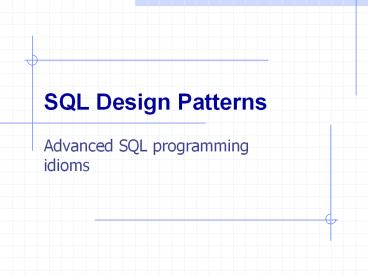SQL Design Patterns - PowerPoint PPT Presentation
Title:
SQL Design Patterns
Description:
SQL Design Patterns Advanced SQL programming idioms Genesis C++ world Advanced C++ Programming Styles and Idioms, by James O. Coplien Design Patterns: Elements of ... – PowerPoint PPT presentation
Number of Views:111
Avg rating:3.0/5.0
Title: SQL Design Patterns
1
SQL Design Patterns
- Advanced SQL programming idioms
2
Genesis
- C world
- Advanced C Programming Styles and Idioms, by
James O. Coplien - Design Patterns Elements of Reusable
Object-Oriented Software by Erich Gamma et al - SQL
- SQL for Smarties by Joe Celko
- SQL Cookbook by Anthony Molinaro
- The Art of SQL by Stephane Faroult, Peter Robson
3
What is a SQL Pattern?
- A common design vocabulary
- A documentation and learning aid
- An adjunct to existing design methods
- A target for refactoring
- Large range of granularity -- from very general
design principles to language-specific idioms
4
List of Patterns
- Counting
- Conditional summation
- Integer generator
- String/Collection decomposition
- List Aggregate
- Enumerating pairs
- Enumerating sets
- Interval coalesce
5
- Discrete interval sampling
- User-defined aggregate
- Pivot
- Symmetric difference
- Histogram
- Skyline query
- Relational division
- Outer union
- Complex constraint
- Nested intervals
- Transitive closure
- Hierarchical total
6
Symmetric Difference
- A B ?
- Isnt it Equality operator ?
7
Venn diagram
B\A
AnB
A\B
(A \ B) ? (B \ A) (A ? B) \ (A n B)
8
SQL Query
- (
- select from A
- minus
- select from B
- ) union all (
- select from B
- minus
- select from A
- )
9
Test
- create table A asselect obj id, name from
sys.objwhere rownum lt 100000 - create table B asselect obj id, name from
sys.objwhere rownum lt 100010
10
Execution Statistics
11
Anti Join Transformation
- convert_set_to_join true
- select from A
- where (col1,col2,) not in (select col1,col2,
from B) - union all
- select from B
- where (col1,col2,) not in (select col1,col2,
from A)
12
Execution Statistics
13
Optimization continued
- CREATE INDEX A_id_name ON A(id, name) CREATE
INDEX B_id_name ON B(id, name) - _hash_join_enabled false_optimizer_sortmerge_jo
in_enabled false - or
- / use_nl(_at_"SEL74086987" A)
use_nl(_at_"SETD8486D66" B)/
14
Symmetric Difference via Aggregation
- select from ( select id, name, sum(case
when src1 then 1 else 0 end) cnt1,
sum(case when src2 then 1 else 0 end) cnt2
from ( select id, name, 1 src from A
union all select id, name, 2 src from B )
group by id, name)where cnt1 ltgt cnt2
15
Execution Statistics
16
Equality checking via Aggregation
- 1. Is there any difference? (Boolean).
- 2. What are the rows that one table contains, and
the other doesn't?
orahash
512259
1523431
17
Relational Division
ApplicantSkills
JobApplicants
JobRequirements
x
18
Dividend, Divisor and Quotient
Remainder
19
Is it a common Pattern?
- Not a basic operator in RA or SQL
- Informally
- Find job applicants who meet all job
requirements - compare with
- Find job applicants who meet at least one job
requirement
20
Set Union Query
- Given a set of sets,
- e.g 1,3,5,3,4,5,5,6
- Find their union
- SELECT DISTINCT element
- FROM Sets
Sets
21
Set Intersection
- Given a set of sets,
- e.g 1,3,5,3,4,5,5,6
- Find their intersection?
Sets
22
Its Relational Division Query!
- Find Elements which belong to all sets
- compare with
- Find Elements who belong to at least one set
/
23
Implementation (1)
- pName(ApplicantSkills) x JobRequirements
24
Implementation (2)
- Applicants who are not qualified
pName (
pName(ApplicantSkills) x JobRequirements
- ApplicantSkills
)
25
Implementation (3)
- Final Query
- pName (ApplicantSkills) -
- pName ( ApplicantSkills -
- pName(ApplicantSkills) x JobRequirements
- )
26
Implementation in SQL (1)
- select distinct Name from ApplicantSkills
- minus
- select Name from (
- select Name, Language from (
- select Name from ApplicantSkills
- ), (
- select Language from JobRequirements
- )
- minus
- select Name, Language from ApplicantSkills
- )
27
Implementation in SQL (2)
- select distinct Name from ApplicantSkills i
- where not exists (
- select from JobRequirements ii
- where not exists (
- select from ApplicantSkills iii
- where iii.Language ii.Language
- and iii.Name i.Name
- )
- )
28
Implementation in SQL (3)
- Name the applicants such that for all job
requirements there exists a corresponding entry
in the applicant skills ?? - Name the applicants such that there is no job
requirement such that there doesnt exists a
corresponding entry in the applicant skills ?? - Name the applicants for which the set of all job
skills is a subset of their skills
29
Implementation in SQL (4)
- select distinct Name from ApplicantSkills i
- where
- (select Language from JobRequirements ii
- where ii.Name i.Name)
- in
- (select Language from ApplicantSkills)
30
Implementation in SQL (5)
- A ? B ?? A \ B Ø
- select distinct Name from ApplicantSkills i
- where not exists (
- select Language from ApplicantSkills
- minus
- select Language from JobRequirements ii
- where ii.Name i.Name
- )
31
Implementation in SQL (6)
- select Name from ApplicantSkills s,
JobRequirements r - where s.Language r.Language
- group by Name
- having count() (select count() from
JobRequirements)
32
Book































